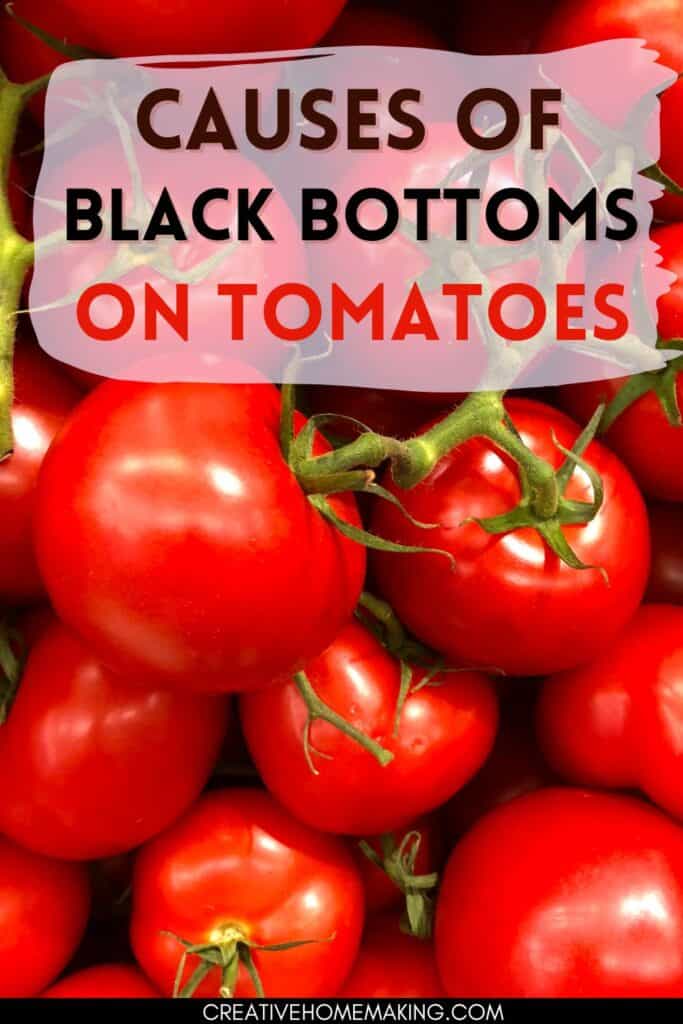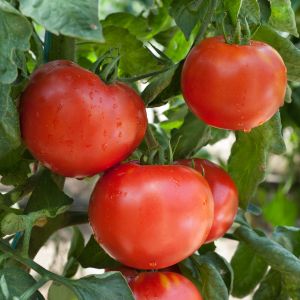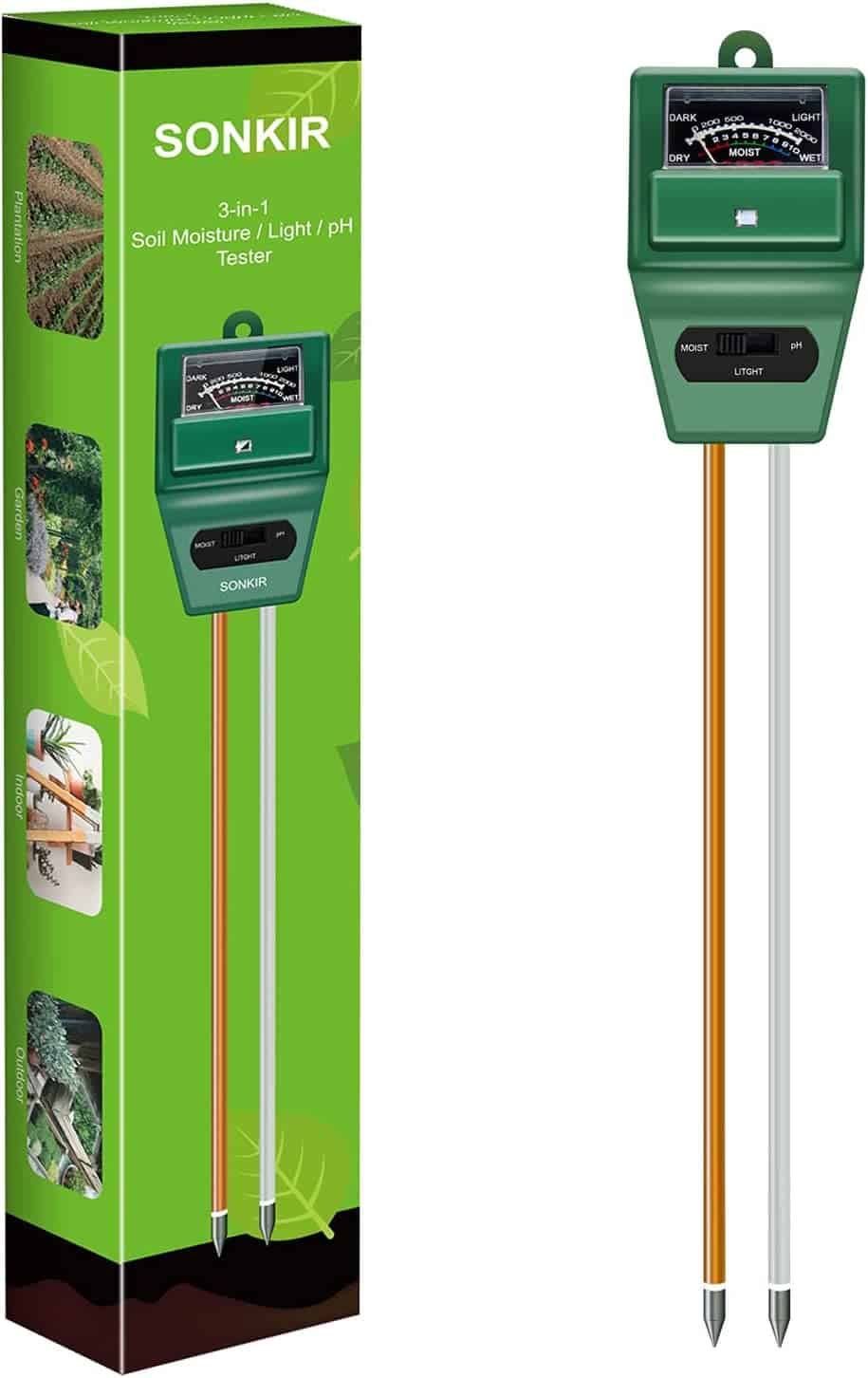Have you ever noticed the bottoms of your tomatoes turning black? This common issue is called blossom end rot, and it can be frustrating for gardeners trying to grow perfect, healthy tomatoes. Fortunately, understanding the causes of this problem can help you learn how to prevent it in the future.
This post may contain affiliate links.
Blossom end rot is caused mainly by a calcium deficiency in the soil, leading to a breakdown of the fruit’s tissue. Other factors like inconsistent watering, excessive nitrogen, and low soil pH can worsen the issue. By knowing these causes and implementing strategies to address them, you can ensure a bountiful harvest of beautiful, unblemished tomatoes.
What Causes Black Bottoms on Tomatoes
Blossom End Rot
If you notice your tomatoes developing black bottoms, it could be a sign of blossom end rot. Blossom end rot occurs when tomato plants suffer from a calcium imbalance in developing fruit and causes black, gray, or brown areas to appear on the bottoms of tomatoes, usually during the fruit’s early development stage.
Related Article: Best Natural Fertilizer for Tomatoes

Calcium Deficiency
Calcium is essential for forming the skin of the fruit. When the tomato plant is unable to take in enough calcium, it experiences this physiological distress. Several factors can impact the plant’s ability to absorb calcium:
- Excessive nitrogen in the soil
- Low soil pH
- Improper watering
Soil pH
The soil pH plays a significant role in the availability of nutrients, including calcium, to plants. A low soil pH can lead to a reduction in the amount of available calcium for the plants to absorb, resulting in the development of blossom end rot. Ensuring your soil has a healthy pH level will help provide the optimal environment for your tomato plants to grow and prevent issues like blossom end rot. You can test the pH of your soil with an inexpensive soil tester like this one.
Related Article: Can Tomatoes Survive Frost?
Soil pH Meter, MS02 3-in-1 Soil Moisture/Light/pH Tester Gardening Tool Kit
Related Article: How to Freeze Whole Tomatoes
By focusing on the factors that contribute to the development of black bottoms on tomatoes, you can take steps to ensure your tomato plants have a balanced supply of nutrients, consistent watering, and a suitable soil pH. Implementing these best practices will give your tomatoes the environment they need to thrive and produce healthy, delicious fruits.
Related Article: Grow Big Tomatoes in Pots: Tips and Tricks for a Bountiful Harvest
Environmental Factors Affecting Tomato Black Bottoms
Temperature and Humidity
When growing tomatoes, it’s crucial to pay attention to temperature and humidity. Excessive temperatures and high humidity can also lead to blossom end rot. This issue also affects peppers and eggplants, as they are part of the nightshade family. To maintain optimal growing conditions, ensure your tomato plants are sheltered from harsh weather and not exposed to extreme heat.
Keep a close eye on your garden’s humidity levels, as constant high humidity can promote the growth of pathogens that may lead to tomato bottom rot. It’s essential to implement proper plant spacing and avoid overwatering to prevent excess moisture around your plants.
Related Article: Best Fertilizer for Peppers

Greenhouse Growing Conditions
If you’re growing tomatoes in a greenhouse, it’s essential to maintain the right environmental conditions for healthy plant growth. Variations in temperature, humidity, and ventilation can cause stress on your tomato plants and increase the likelihood of black bottoms.
In a greenhouse setting, monitor and control temperature levels, ensuring they don’t surpass the desired range. Adequate ventilation is vital for preventing high humidity inside the greenhouse, so consider using ventilation systems or wind breaks to regulate air circulation. Regularly inspect your greenhouse for pests, as they might damage the roots, contributing to tomato bottom rot.
Related Article: The Best Compost for Tomatoes
Gardening Practices
Adopting proper gardening practices can help minimize the likelihood of tomato bottoms turning black. Consider the following tips when growing tomatoes in your home garden:
- Select well-adapted tomato varieties for your area, as these are less susceptible to stress factors
- Maintain your garden soil at a consistent moisture level to prevent stress on your tomato plants
- Apply mulch around the base of your plants to help retain moisture and suppress weed growth, which will minimize root damage
- Be cautious when weeding, staking, or undertaking other activities that could potentially harm your tomato plants’ root system.
Tips to Improve Tomato Health and Yields
Soil Preparation
To enhance your tomato plants’ health and yield, start with proper soil preparation. Tomatoes thrive in well-drained, loamy soil with a pH between 6.0 and 6.8. Prepare your soil by adding organic matter such as compost, aged manure, or peat moss to increase fertility and improve drainage.
Related Article: Canning Diced Tomatoes
Pay attention to the nutrient levels in your soil, particularly nitrogen, phosphorus, and potassium. Test your soil’s pH and acidity levels to ensure they fall within the recommended range, as excessively acidic soil can lead to issues like blossom-end rot.
Fertilizer Application
Use a balanced, slow-release fertilizer at the time of planting your tomatoes to provide essential nutrients like nitrogen, phosphorus, and potassium. High nitrogen fertilizers can promote excessive foliage growth at the expense of fruit production, so opt for a balanced approach. Maintaining appropriate moisture levels is crucial to nutrient uptake and preventing diseases like blossom-end rot. Avoid over-watering or under-watering, aim for consistent soil moisture.
Related Article: How to Prune Tomatoes for a Bountiful Harvest
Use of Organic Materials
Incorporate organic materials such as crushed eggshells or bone meal into your soil to prevent deficiencies in calcium and other micronutrients. Calcium is essential for proper cell wall development and helps avoid the occurrence of blossom-end rot. Add a calcium fertilizer or foliar spray if necessary. Use organic mulches like straw, grass clippings, or wood chips to maintain moisture levels, regulate soil temperatures, and suppress weeds.
Consider using plastic mulch to further improve temperature control, water retention, and weed suppression. Rot-stop products can also help manage blossom-end rot by providing a readily available source of calcium. Addressing issues such as pH imbalances, choosing the right fertilizers, and incorporating organic materials can significantly improve the overall health and yields of your tomato plants.
Follow my gardening board on Pinterest.



